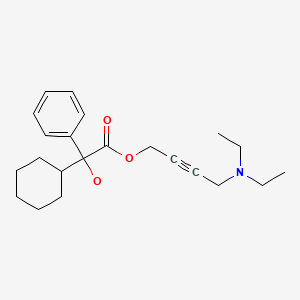Attribution Statement: LactMed is a registered trademark of the U.S. Department of Health and Human Services.
NCBI Bookshelf. A service of the National Library of Medicine, National Institutes of Health.
Drugs and Lactation Database (LactMed®) [Internet]. Bethesda (MD): National Institute of Child Health and Human Development; 2006-.
CASRN: 5633-20-5

Drug Levels and Effects
Summary of Use during Lactation
No information is available on the use of oxybutynin during breastfeeding. Long-term use of oxybutynin might reduce milk production or milk letdown, but a single dose is not likely to interfere with breastfeeding. During long-term use, observe for signs of decreased lactation (e.g., insatiety, poor weight gain).
Drug Levels
Maternal Levels. Relevant published information was not found as of the revision date.
Infant Levels. Relevant published information was not found as of the revision date.
Effects in Breastfed Infants
Relevant published information was not found as of the revision date.
Effects on Lactation and Breastmilk
Anticholinergics can inhibit lactation in animals, apparently by inhibiting growth hormone and oxytocin secretion.[1-5] Anticholinergic drugs can also reduce serum prolactin in nonnursing women.[6] The prolactin level in a mother with established lactation may not affect her ability to breastfeed. The manufacturer reports that cases of lactation suppression have been reported with some oxybutynin (immediate-release) formulations in postmarketing surveillance.[7]
References
- 1.
- Aaron DK, Ely DG, Deweese WP, et al. Reducing milk production in ewes at weaning using restricted feeding and methscopolamine bromide. J Anim Sci. 1997;75:1434–42. [PubMed: 9250502]
- 2.
- Powell MR, Keisler DH. A potential strategy for decreasing milk production in the ewe at weaning using a growth hormone release blocker. J Anim Sci. 1995;73:1901–5. [PubMed: 7592071]
- 3.
- Daniel JA, Thomas MG, Powell MR, et al. Methscopolamine bromide blocks hypothalmic-stimulated release of growth hormone in ewes. J Anim Sci. 1997;75:1359–62. [PubMed: 9159285]
- 4.
- Bizzarro A, Iannucci F, Tolino A, et al. Inhibiting effect of atropine on prolactin blood levels after stimulation with TRH. Clin Exp Obstet Gynecol. 1980;7:108–11. [PubMed: 6788407]
- 5.
- Svennersten K, Nelson L, Juvnäs-Moberg K. Atropinization decreases oxytocin secretion in dairy cows. Acta Physiol Scand. 1992;145:193–4. [PubMed: 1636447]
- 6.
- Masala A, Alagna S, Devilla L, et al. Muscarinic receptor blockade by pirenzepine: Effect on prolactin secretion in man. J Endocrinol Invest. 1982;5:53–5. [PubMed: 6808052]
- 7.
- Ditropan XL package insert. Janssen Pharmaceutical, Inc., Titusville, NJ. August, 2017.
Substance Identification
Substance Name
Oxybutinyn
CAS Registry Number
5633-20-5
Drug Class
Breast Feeding
Lactation
Muscarinic Antagonists
Parasympatholytics
Disclaimer: Information presented in this database is not meant as a substitute for professional judgment. You should consult your healthcare provider for breastfeeding advice related to your particular situation. The U.S. government does not warrant or assume any liability or responsibility for the accuracy or completeness of the information on this Site.
- User and Medical Advice Disclaimer
- Drugs and Lactation Database (LactMed) - Record Format
- LactMed - Database Creation and Peer Review Process
- Fact Sheet. Drugs and Lactation Database (LactMed)
- Drugs and Lactation Database (LactMed) - Glossary
- LactMed Selected References
- Drugs and Lactation Database (LactMed) - About Dietary Supplements
- Breastfeeding Links
- PubChem SubstanceRelated PubChem Substances
- PubMedLinks to PubMed
- Oxybutinyn - Drugs and Lactation Database (LactMed®)Oxybutinyn - Drugs and Lactation Database (LactMed®)
Your browsing activity is empty.
Activity recording is turned off.
See more...
